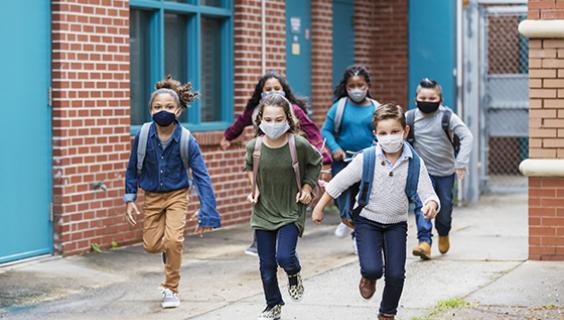How Expanded Learning Programs and Schools Work Together to Support California Students During the COVID-19 Pandemic

COVID-19 created a host of new challenges for educators and exacerbated many preexisting ones. Conversely, the pandemic also provided educators and policymakers with opportunities to innovate, become more adaptive, and learn best practices that will continue to be relevant long after the crisis has passed.
AIR partnered with Policy Analysis for California Education (PACE) and the Partnership for Children and Youth to create resources that help educators support students in these unprecedented circumstances. These three resources cover strengthening partnerships between expanded learning programs and schools; planning integrated whole child supports; and designing in-person learning hubs.
In this Q&A, Femi Vance, Ph.D., an AIR researcher, discusses these approaches and their connection to equity.
Q: How has COVID-19 affected expanded learning programs? And how have the programs helped students?
Vance: Expanded learning programs have quickly and creatively figured out how to keep serving families. According to the Afterschool Alliance, when the pandemic hit last year, 25% of programs nationwide closed; as of March 2021, only 3% are closed.
In December, California’s Afterschool Network (CAN) released a report on the state of afterschool programs. Remarkably, it showed that California’s expanded learning programs continue to serve students who have been hardest hit by the COVID-19 pandemic, including Black and Latinx students, English language learners, and students who are living in poverty. That’s really important, because the evidence tells us that high-quality expanded learning programs lead to measurable positive outcomes for students, including improved school attendance and stronger social and emotional skills.
Throughout the pandemic, CAN has hosted a series of fireside chats, which are virtual conversations to discuss how the pandemic is affecting expanded learning providers and helping decisionmakers understand what expanded learning providers need to better serve youth during the pandemic. In our brief on expanded learning partnerships, we argue that these partnerships are a critical ingredient for serving students during this public health crisis.
California’s expanded learning programs have pivoted in all sorts of ways. For instance, they deliver meals to families who are struggling, and they help families without internet obtain educational resources. In a few instances, expanded learning programs have been able to help social services connect with hard-to-reach families, because they can draw upon existing relationships. Some programs have kept their doors open, providing child care to the children of essential workers. In general, they’ve continued to offer emotional support and connection, which is essential in these socially distant times.
Q: Why is it important for schools and districts to coordinate on expanded learning programs, and what are some takeaways from AIR’s work on how to strengthen those partnerships?
Expanded learning refers to the programs that operate outside of the normal class hours—before and after school, in the summer, and over holiday breaks. Such programs offer students a whole host of supports and learning opportunities: a safe and supportive learning environment, academic enrichment, caring adults, opportunities to build peer relationships, social and emotional support, and fun. California has 4,500 expanded learning programs that serve more than 900,000 children, and there’s demand for even more.
Vance: I think a lot of educators don’t want to go back to the system we had before. There were major disparities in how students were being served, and the pandemic provides an opportunity to reimagine the system to eliminate those gaps. Many programs are really just starting to think about equity, but this requires intentionality: Equity has to be defined, and existing barriers have to be named and identified before they can be dismantled.
Partnerships between schools and expanded learning programs have always been important; the pandemic has reinforced that point. We can leverage those partnerships to create a seamless learning experience from school to afterschool and also provide equitable learning opportunities. Implementing that kind of programming—one that meets the needs of each student—requires collaborative planning. That way, both partners can establish shared goals and make adjustments to achieve them. Our discussion tool offers guiding questions that can be used in collaborative meetings about whole child learning opportunities. Schools and expanded learning partners can use these questions to initiate conversations about a range of topics, including equity.
Q: Learning hubs have become an important component of our education system during the pandemic. What exactly are they, and what are some attributes of successful hubs?
Vance: Learning hubs are a new model, born out of necessity during the pandemic, and they’re continually evolving. Essentially, they offer small groups of students in-person academic support. These students engage in distant learning, but there are adults on-site who can support them. After class, these adults usually offer enrichment activities, snacks, and opportunities to go outside for physical activity. In our learning hubs brief, we describe the design of a prominent learning hub model in California.
Because learning hubs are still quite new, we’re just starting to study them. The learning hub model we learned about in California tended to serve students who are most impacted by COVID-19—children of essential workers, families without internet, foster youth, and others. Offering learning hubs is one strategy to provide a more equitable learning experience for such students.
Equity isn’t just a factor for students. For instance, there’s a big difference between teachers and expanded learning staff in terms of wages and access to health care. In California, most of the adults operating learning hubs are expanded learning staff. With expanded learning staff continuing to serve students in person through the hubs, it’s important to invest in them so that they have the resources they need to keep showing up. That includes everything from access to COVID-19 testing to a living wage. It’s worth noting, too, that demographically, expanded learning program staff are mostly women of color, who have been disproportionately affected by the pandemic. It would be really unfortunate if their work conditions exacerbated those inequities.
Q: Many children are returning or have returned to in-person schooling after learning elsewhere for some time. What supports will they need, and how can partnerships between schools and expanded learning programs help?
Vance: We know from our analysis of reopening plans that states are elevating the critical need to provide whole child supports to students, including social and emotional supports and mental health services. As I see it, supports for social and emotional learning and development are built into the fabric of expanded learning programs. As expanded learning programs and schools better integrate learning, as I described earlier, it would be great if that led to more active conversations about strengthening social and emotional learning and development across the school day and expanded learning programs.
For mental health, expanded learning programs typically don’t have a mental health professional on site. But these programs can be a wonderful resource to make referrals to local free- and low-cost mental health service providers. They also can serve as an early warning system for families whose children are experiencing mental health issues. This is important because the earlier that problems are identified and treated, the better the outcomes are likely to be.
Q: What are some lessons learned for both California and other states as they address the current educational challenges the pandemic poses, but also anticipate new challenges after the pandemic ends?
Vance: One very exciting lesson is that these innovative partnerships are possible, because they’re building on existing strengths and assets. The current structure is not necessarily optimized, but there are a lot of opportunities available. For example, the California governor’s 2021-2022 proposed budget allocates $4.55 billion for expanded learning time and academic interventions, which includes expanded learning programs. We’ve also seen California become more flexible on the grant requirements for these programs, and this has allowed programs to continue serving families in spite of the pandemic.
Another major takeaway is that we should be thinking about how to help children succeed on every level, figuring out what families need and how we can provide it. That’s the approach expanded learning programs in California have taken during the pandemic, but it would also serve us well even when this moment passes.
Lastly, we should continue to focus on equity. Even after the pandemic, we need to continue to ask ourselves: Who do we typically not hear from? How do we get them what they need? In other words, How can our partnerships continue to chip away at systemic inequities?
